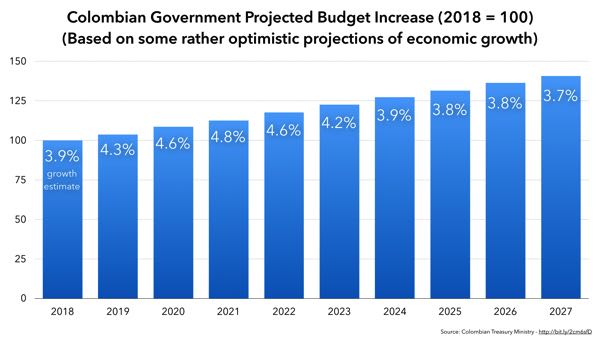Should Colombia agree on a peace accord with the Revolutionary Armed Forces of Colombia (FARC) guerrilla group—an outcome we view as likely—it will need to devote generous resources to implementing some costly commitments that those accords make.
Colombia is a vast country, and its vastness includes numerous areas where communities’ most basic needs—from security to roads to education—are unmet. The accords developed with the FARC, especially agreements on rural development and addressing illicit crops, contain the outlines of a blueprint for meeting these needs.
But doing this is going to be expensive. Estimates of the 10-year cost of complying with accord commitments range from about US$45 billion to US$100 billion or more. Funds from international donors are unlikely to total more than US$1 billion per year. As a result Colombia, a middle-income country, will have to pay for most of the implementation by itself.
Colombia doesn’t appear to be planning to do this. If it were, one would expect to see Colombia’s government contemplating a big jump in spending in the immediate post-accord period. But budget projections show no such jump. Colombia’s Treasury Ministry shows only slight increases, if any, amid an effort to reduce deficit spending.
The lack of a large initial spending push to implement peace commitments owes to Colombia’s economic slowdown, which despite budget cuts has left a 2016 budget deficit equivalent to 3.9 percent of GDP. Colombia is now considering a package of tax increases to close that gap; this package is quite regressive, as it relies heavily on a sales tax increase that will hit the poorest.
Further evidence that Colombia plans no post-conflict spending push is in the royalties that Bogotá plans to distribute from income gained from oil, the country’s most lucrative export commodity. This week, the Colombian Congress is debating the government’s 2017-18 plan to distribute royalties throughout its 32 departments, or provinces.
Again, one would expect to see departments hit hardest by the conflict to see the largest increases in oil royalty distributions. Again, that is not happening.
WOLA staff met this past weekend in Putumayo department with its governor, Sorrel Aroca, a Green Party politician elected a year ago with support from many local social movements. She was livid at the news that Putumayo would receive only modest additional investment from oil royalties.
She showed WOLA staff photos she had taken from a PowerPoint presentation given to governors by Colombia’s Treasury Ministry, which showed Putumayo getting a 12 percent increase for 2017-18 over 2015-16, but some other non-oil-producing, less-conflict-affected departments getting much greater increases (Quindío 31%, Risaralda 28%, Caldas 27%). “I support the oil investments in Putumayo,” she said, “but they do have an environmental and social cost, and the oil royalties are compensation for that. If they’re only going to give us crumbs from the royalties, then maybe we shouldn’t allow even a drop of oil to flow. I want to know what criteria they use to decide on territorial increases in royalties.”
Governor Aroca says Putumayo needs roads: paved roads are the best way to make legal crops marketable in a department that is now Colombia’s second-largest coca producer. (Indeed, WOLA staff saw a lot of coca on a weeklong trip to Putumayo, but never from a paved road.) Paving roads is expensive, though: doing so can cost US$300,000 or more per mile.
WOLA hopes that the government of Colombia will reconsider its distribution of oil royalties in a way that provides healthier increases to zones hardest-hit by the conflict, especially oil-producing areas like Putumayo. Doing so would send a strong message to the international donor community that Colombia truly plans to accompany foreign contributions with strong local investment to pay for implementing peace accord commitments.


